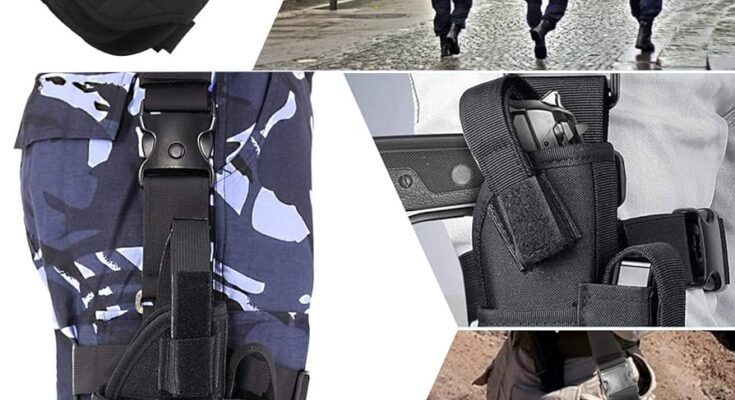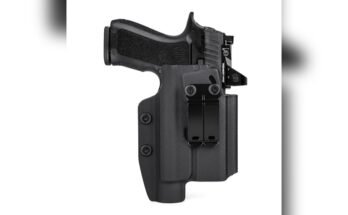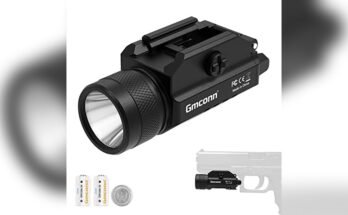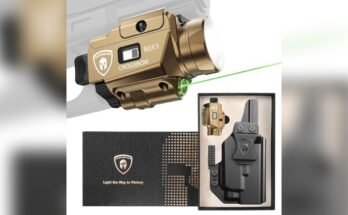I’ve carried on the range, trained with law enforcement instructors, and tested dozens of rigs in real-world drills. So when people ask, what is a drop leg holster?, here’s the straight answer: it’s a holster that rides on your thigh, attached to your belt and strapped to your leg, to move the gun below your waistline for faster access and more comfort with bulky gear. If you want quicker draws with a plate carrier or a long jacket, a drop leg holster can shine. Let’s break it down in plain language, with real tips you can use today.

Source: inside.safariland.com
Definition: What A Drop Leg Holster Actually Is
A drop leg holster, also called a thigh holster or leg rig, is a holster platform that hangs from the belt and sits mid-thigh. It uses one or two vertical straps from the belt and one or two horizontal thigh straps to secure the rig.
The purpose is simple. It lowers the pistol below body armor, chest rigs, or a thick coat. This creates clear space for your hand to grip, improving draw speed and comfort when your waistline is crowded.
Most modern rigs use a modular panel. You attach a holster shell for your specific pistol and add accessories like magazine pouches or a tourniquet carrier.

Source: blade-tech.com
Key Components And How They Work
– Belt hanger: Connects the panel to your belt. Often a rigid polymer arm or adjustable strap for ride height.
– Thigh panel: A semi-rigid platform that spreads weight and keeps the holster stable.
– Thigh straps: One or two straps with rubberized backing to reduce slip and bounce.
– Holster shell: Kydex or polymer shell shaped to your pistol, with light-bearing options.
– Retention system: Passive friction or active locks. Common ratings are Level I, Level II (e.g., hood), and Level III (e.g., hood plus lever).
– Quick-detach interfaces: Systems that let you swap holsters or move from belt to leg rig fast.
In practice, stability and retention matter more than brand names. A solid, non-flexing mount with proper strap tension prevents wobble and protects your trigger.

Source: inside.safariland.com
Benefits And Trade-Offs
Benefits:
– Faster access with armor, chest rigs, and long jackets.
– Cleaner draw stroke when waistline is crowded with pouches.
– Better ergonomics for some body types or shoulder mobility limits.
Trade-offs:
- More bulk and snag potential in tight spaces or vehicles.
- Can slap or shift when running if not adjusted well.
- Adds one more piece of kit to manage in training and maintenance.
My take from range days: a well-fitted drop leg holster feels invisible. A poorly adjusted one will make you fight the gun on every draw.
Who Should Consider One?
– Range shooters using plate carriers or battle belts.
– Law enforcement or security with outer carriers or duty loadouts, when policy allows.
– Hunters or outdoors users wearing heavy layers or hip belts on packs.
– Competitive shooters in certain divisions when rules permit.
If you carry concealed daily, a drop leg is usually not ideal. For duty or training with gear, it can be a smart tool.
Fit, Sizing, And Ride Height
Ride height is the secret sauce. Aim for high-thigh, not knee-level. The grip should sit just below your belt line, where your hand naturally falls.
Tips:
- Keep the panel as high as comfort allows.
- Use two thigh straps for added stability if you run or go prone often.
- Tension thigh straps snug but not tight. You should fit two fingers under the strap to avoid circulation issues.
- Choose a holster shell matched to your exact pistol and light. Small differences matter.
A quick mirror test: bend, squat, and jog in place. If the rig climbs, twists, or hits your knee, adjust ride height and strap tension.
Setting It Up: Step-By-Step
– Thread the belt hanger onto a sturdy belt. A 1.75-inch duty or battle belt is ideal.
– Position the panel on the outer thigh, not centered or on the front.
– Adjust ride height so the grip is a natural reach from your relaxed hand.
– Set thigh straps snug, check for hotspots after a few minutes of movement.
– Test retention. Try light jumps and sprints. The gun should not shift or rattle.
– Do 20 slow, clean practice draws, re-holster with care, then add speed.
From experience, small changes of a half inch can transform comfort and speed.
Training, Safety, And Best Practices
– Keep the muzzle off your leg when re-holstering. Move your hips slightly forward and look the gun back in until the motion is automatic.
– Practice with duty retention devices until you can defeat them without thinking.
– Use dummy rounds or a blue gun early in your reps.
– Follow range commands and safe directions at all times. Treat every firearm as loaded, keep your finger off the trigger until on target, and know your target and what’s beyond it.
– Avoid soft nylon holsters that can collapse. A rigid, molded shell protects the trigger.
I learned the hard way that loose straps equal ugly draws. Five minutes of setup beats months of bad reps.
Materials, Durability, And Maintenance
– Kydex or injection-molded polymer shells resist moisture and keep shape.
– Nylon panels with stiffeners balance comfort and rigidity.
– Rubberized or silicone-backed straps reduce slip.
– Stainless or coated hardware resists rust.
Care basics:
- Wipe dust and sand from the shell and retention points.
- Check screws monthly. Use thread locker when the setup is final.
- Replace frayed straps. Inspect after heavy rain or mud.
Alternatives: Drop Leg Vs. Other Carry Options
– Belt-mounted duty holster: Faster for plain uniforms but clashes with armor.
– Mid-ride on belt with offset: A good compromise; lower than high-ride, higher than full drop leg.
– Chest holster: Great with backpacks, slower for some users.
– Inside-the-waistband: Best for concealment, not for duty gear.
If you only need a small clearance from armor, try a mid-ride with a slight offset before going full thigh rig.
Buying Guide: Features That Matter
– Compatibility: Exact pistol and light fit, optic-ready clearance, compensator space if needed.
– Retention level: Level II or III for duty; Level I may be fine for range use.
– Quick detach: Useful if you swap platforms or share gear.
– Strap quality: Anti-slip backing and low-stretch webbing.
– Panel stiffness: Enough rigidity to prevent twist without creating hot spots.
– Support: Availability of spare parts and documented fit charts.
Pro tip: bring your belt, pistol, and light to the store, or verify the manufacturer’s fit list before ordering. Returns are costly in time.
Legal And Policy Notes
– Always follow local laws on open carry, transport, and handgun features.
– Duty users must follow agency policy on retention levels and mounting height.
– Some ranges restrict leg rigs due to safety concerns. Ask first and train accordingly.
When in doubt, get written guidance. Policies change faster than gear does.
Real-World Lessons From The Range
On a rainy carbine class, my belt holster kept colliding with mag pouches and armor. Swapping to a high-riding drop leg cut my draw times by a third and stopped the “gear clash.” But I also learned that one thigh strap wasn’t enough for sprinting and kneeling. Adding a second strap and raising the ride height fixed the wobble without slowing my draw.
Mistakes to avoid:
- Running the rig too low. It feels cool, performs poorly.
- Ignoring retention practice. Under stress, your hand will forget the hood if you haven’t trained.
- Overtightening straps. Numb legs and slower movement follow.
Frequently Asked Questions Of What Is A Drop Leg Holster?
Is A Drop Leg Holster Good For Everyday Carry?
It’s not ideal for concealment. It’s better for duty, training, or use with armor and heavy layers.
What Ride Height Is Best?
High-thigh. Keep the grip just below the belt line so your hand finds it naturally.
Do I Need Level II Or Level III Retention?
For duty or public work, yes, follow policy. For range use, Level I can work if you train and maintain muzzle discipline.
Will It Work With A Weapon Light Or Optic?
Yes, if the shell is designed for your exact pistol and light, with optic clearance.
How Do I Stop The Holster From Flopping While Running?
Use two thigh straps, snug tension, a stiff panel, and keep the ride height high. Check belt stiffness too.
Can I Use It In A Vehicle?
It can snag in tight cabins. A mid-ride belt holster may be better for frequent driving.
Is Nylon Or Kydex Better?
A nylon panel with a Kydex or polymer shell is a reliable combo. Fully soft nylon holsters can collapse and are less safe.
Wrap-Up And Next Steps
A drop leg holster moves your pistol to the thigh for cleaner access around armor, jackets, and gear. Set it high, keep straps snug, and train your retention. Choose a rigid shell matched to your gun and light. Start with short, safe reps, then build speed.
If you run gear or train with armor, try a high-thigh setup and track your draw times. You’ll know fast if it’s your solution. Want more? Explore our other guides, subscribe for updates, or drop a comment with your setup and questions.
Watch This Video on What is a drop leg holster?



